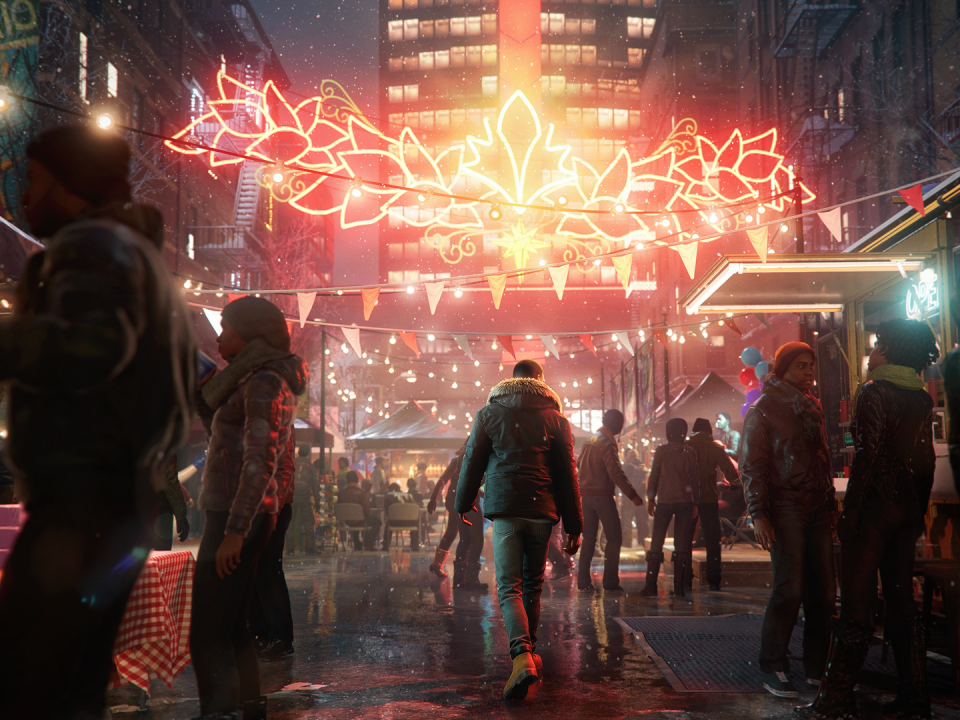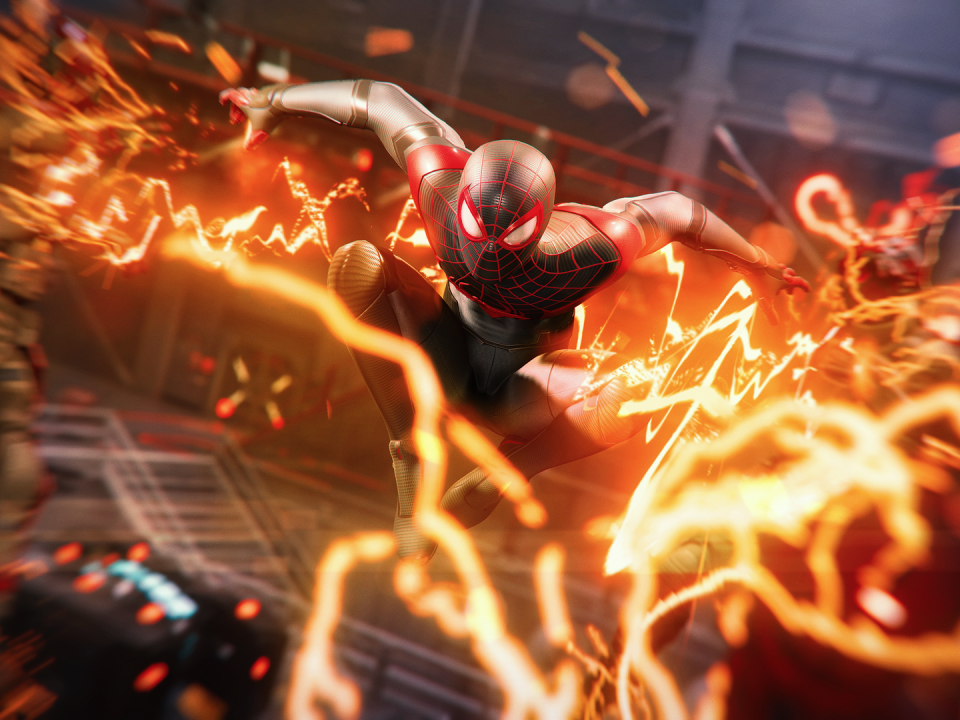What strikes you first about Marvel’s Spider-Man: Miles Morales is how positively electric the game feels. Bursting out of the New York City subway with fanfare, Insomniac’s new game—which is less of a sequel and more of an in-betweequel for the first title and whatever, inevitably, is going to come next—begins on the streets of Harlem, where massive street murals cover every building and 808s blare. Miles, bopping along to the beats on his headphones, struts through the chilly air, fist-bumping his neighbors and offering a hand to anyone in need. We learn right away that Miles’s mother is running for a local political seat, and as we pass by a few campaigners on the street, the community here in Harlem already begins to have a much more tangible presence than the relatively generic Manhattan in its predecessor.
For a while now, Insomniac has been telling us that the Harlem in this game, which releases for the PS4 and as a PS5 launch title on November 12, is going to feel like a living, breathing place. And it does. But it’s not because the textures and the character models are more realistically rendered, or anything like that. It’s because care has clearly been put into representing, accurately, a neighborhood that is as colorful as the world we live in. For a game as short as Miles Morales, that vibrancy goes a long, long way.
Insomniac’s first Spider-Man game was deliciously fun to play, offering a wholesome, uncynical take on the superhero genre. But as refreshing as it was, it was pasty—and predictable—as hell. All the main characters were white, we’ve seen the love story of Peter Parker and Mary Jane Watson play out a million times before, Doc Ock’s big transformation was way too easy to forecast, and although we got a glimpse of the Brooklyn-born Miles and the trauma surrounding his policeman father, the only minority character in the game might as well have been an NPC. And that was a damn shame, because Miles’s story was the only unpredictable one.
Lack of predictability is Miles Morales’s biggest asset. Most of us are well acquainted with the many, many storylines in Peter Parker’s history. He’s been around since 1962. Miles Morales was created in 2011. So, unless you’re hugely invested in the comics, the Spider-Man from Brooklyn (well, Harlem, in this game) is a brand new character. Most of his earliest narrative threads are still being spun. Man, even though you’ll probably finish the game’s tragically bite-sized narrative in about three or four sittings, that joy of discovery really sticks with you.
Still, although Miles Morales abandons the tired (and white) narratives of Peter Parker lore for something energizingly different, it is, despite its best efforts, stuck in Pete’s world nonetheless. A lot of us were hoping Miles Morales would be a sequel to the 2017 title, but Insomniac made it pretty clear back in June that this would be something closer to a narrative expansion to the first game. What this meant, exactly, was confusing. Would it be a DLC package? Or a sequel that was limited in size?
I felt deflated to find out that Miles Morales is somewhere in between the two. It’s far and away the best DLC continuation of a game that I’ve ever played. But as a sequel, it’s the lousiest one in recent memory. I had high hopes that Miles would get as deep of a narrative as Pete did—a narrative that’s as deep as he deserves—but in the roughly eight hours of story in this game, there’s really only about four sequences that feel like they’re on the same scale as 2017’s Spider-Man. The game follows Miles through his turbulent winter break, as he struggles to balance spending time with his friends, his family, and, you know, being a superhero. Pete leaves town right as two warring factions have begun to exchange blows over a dangerous new form of energy that may (spoilers ahead!) destroy the entirety of Harlem. It’s up to Miles to keep his home intact. Great setup for a Spider-Man story, right?
Eh, it would be, if it had the complexity that you’d expect from a huge, story-centric, one-player title like this. But unlike the past game, where the bigger calamity was woven into a huge web of interconnected conflicts, in Miles Morales, the big A-plot is really the only plot. Everything else—and there’s not too much else—feels like filler. It’s such a bummer, especially because the characters introduced here are so much more appealing than the exhausting Sinister Six of the first game. I wish I got to know them better!
Same goes for how the title performs on the PS5. The game loads up right away, and you’re able to see the city with more clarity and complexity. But aside from some of the flashier cinematics (of which there are very few), it doesn’t look all that different from recent PS4 games, despite all the marvels of technology that Sony has been saying are present in it. (I should point out, I’m reviewing this game before its Day 1 patch, which will evidently beef up the HDR and polish a few things.) When Sony refers to Miles as its “showpiece” for the PS5, I expect to see something that looks strikingly upgraded from, say, Ghost of Tsushima, which is absolutely ravishing on the PS4 Pro compared to what I’m seeing here. I know, it’s early in this new console generation. But, I can’t help but wonder if Insomniac was pressured to get this game out the door so Sony could tout it as a launch title on the PS5.
That doesn’t mean Miles isn’t worth playing, though. Absolutely not. It’s a blast from start to finish! And best of all, it feels new in all kinds of ways. Though the Manhattan of the game may be pretty much the same as the one from the 2017 game (except for some remodeling, especially around the Harlem region), there is a distinct happiness from swinging through it as Miles. Since this Spider-Man is still new to being a superhero, he flails around as you soar through the air, often falling upside down (perhaps a nod to the 2018 Spider-Verse movie) and wheeling his arms as he hurtles toward the building tops. Miles is scrappier than Pete—instead of some high-tech Spider armor, Miles starts the game with just a Spidey mask, hoodie, gym shorts, and a pair of Jordans. Instead of a big arsenal of gadgets, Miles’s combat is all about his newfound powers, like his supercharged bioelectricity, which crackles and bursts with color, one of the only gameplay mechanics that really takes advantage of the PS5’s impressively articulate lighting effects.
The side missions, too, are fun—and different. Whereas the last game had you tracking down pigeons, this one has you poring over the city to identify sound sources for a beat generator. Stealth is a lot more stimulating this time around, because one of Miles’s mutations allows him to turn completely invisible. This means you can sneak up on bad guys in a completely new way, taking them down in clear sight before zipping off to the shadows to recharge your invisibility. And just as in the first game, there are a ton of unrecognizable suits to unlock, which will definitely add a bunch of hours to the relatively tiny playtime.
It’s not the suits, or the combat, or the gameplay at all, really, that makes Miles Morales such a joy to experience. To me, it’s the fact that it feels like a novel story in a superhero genre full of the same old traditions. Miles, his mother, his friends, and his enemies—they’re a humble crew of folks from an underrepresented setting who don’t often get to be the leading cast of a game of this scale. The music has an unexpected hip hop flair, Harlem is bursting with personality, and so many of the peripheral characters, like Teo the bodega guy (and his cat, who is named Spider-Man), are faces that we’d never normally meet in a video game.
Miles Morales proves something that we’ve started to see in a number of blockbuster video games lately. As in The Last of Us Part II, which skipped the whole “tortured white man” thing in favor of a stirring narrative about two queer women and a transgender youth, Miles Morales shows again that, when a story becomes more diverse, it doesn’t only become more realistic—it becomes more interesting. It’s a promising next step for an industry that, for decades, has stubbornly focused on one kind of character and one kind of story, so much that the idea of centering a narrative in a place as legendary as Harlem still feels, somehow, unpredictable. That’s what makes it so exciting that, for many, Miles will be the first character they get to know and love on the PS5. I only wish I got to spend more time with him before the credits rolled.
You Might Also Like


